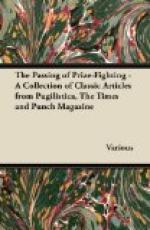[Illustration: EMBEDDED IN QUARTS(Z).]
* * * * *
THE WAPPING DELUGE.
Father Thames, not content with his customary course, has been “swelling it” in the course of the week, through some of the streets of the metropolis. As if to inculcate temperance, he walked himself down into public-house cellars, filling all the empty casks with water, and adulterating all the beer and spirits that came in his way; turning also every body’s fixed into floating capital. Half empty butts, whose place was below, came sailing up into the bar through the ceiling of the cellar; saucepans were elevated from beneath the dresser to the dresser itself; while cups were made “to pop off the hooks” with surprising rapidity.
But the greatest consternation that prevailed was among the rats, particularly those in the neighbourhood of Downing-street, who were driven out of the sewers they inhabit with astounding violence.
The dairies on the banks of the Thames were obliged to lay aside their customary practice of inundating the milk; for such a “meeting of the waters” as would otherwise have ensued must have proved rather too much, even for the regular customers.
* * * * *
SAVORY CON. BY COX.
Why is it impossible for a watch that indicates the smaller divisions of time ever to be new?—Because it must always be a second-hand one.
* * * * *
PUNCH’S INFORMATION FOR THE PEOPLE.—No. V.
NATURAL HISTORY (Continued).
THE OPERA-DANCER (H. capernicus—CERITOE).
So decidedly does this animal belong to the Bimana order of beings, that to his two legs he is indebted for existence. Most of his fellow bipeds live by the work of their hands, except indeed the feathered and tailor tribes, who live by their bills; but from his thighs, calves, ancles, and toes, does the opera-dancer derive subsistence for the less important portions of his anatomy.




